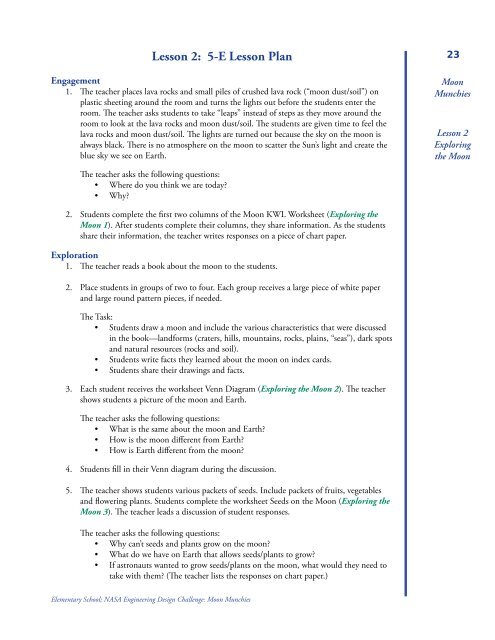Moon Munchies 2 pdf - ER - NASA
Moon Munchies 2 pdf - ER - NASA
Moon Munchies 2 pdf - ER - NASA
Create successful ePaper yourself
Turn your PDF publications into a flip-book with our unique Google optimized e-Paper software.
Lesson 2: 5-E Lesson PlanEngagement1. The teacher places lava rocks and small piles of crushed lava rock (“moon dust/soil”) onplastic sheeting around the room and turns the lights out before the students enter theroom. The teacher asks students to take “leaps” instead of steps as they move around theroom to look at the lava rocks and moon dust/soil. The students are given time to feel thelava rocks and moon dust/soil. The lights are turned out because the sky on the moon isalways black. There is no atmosphere on the moon to scatter the Sun’s light and create theblue sky we see on Earth.23<strong>Moon</strong><strong>Munchies</strong>Lesson 2Exploringthe <strong>Moon</strong>The teacher asks the following questions:• Where do you think we are today?• Why?2. Students complete the first two columns of the <strong>Moon</strong> KWL Worksheet ( Exploring the<strong>Moon</strong> 1). After students complete their columns, they share information. As the studentsshare their information, the teacher writes responses on a piece of chart paper.Exploration1. The teacher reads a book about the moon to the students.2.Place students in groups of two to four. Each group receives a large piece of white paperand large round pattern pieces, if needed.The Task:• Students draw a moon and include the various characteristics that were discussedin the book—landforms (craters, hills, mountains, rocks, plains, “seas”), dark spotsand natural resources (rocks and soil).• Students write facts they learned about the moon on index cards.• Students share their drawings and facts.3. Each student receives the worksheet Venn Diagram ( Exploring the <strong>Moon</strong> 2). The teachershows students a picture of the moon and Earth.The teacher asks the following questions:• What is the same about the moon and Earth?• How is the moon different from Earth?• How is Earth different from the moon?4.5.Students fill in their Venn diagram during the discussion.The teacher shows students various packets of seeds. Include packets of fruits, vegetablesand flowering plants. Students complete the worksheet Seeds on the <strong>Moon</strong> (Exploring the<strong>Moon</strong> 3). The teacher leads a discussion of student responses.The teacher asks the following questions:• Why can’t seeds and plants grow on the moon?• What do we have on Earth that allows seeds/plants to grow?• If astronauts wanted to grow seeds/plants on the moon, what would they need totake with them? (The teacher lists the responses on chart paper.)Elementary School; <strong>NASA</strong> Engineering Design Challenge: <strong>Moon</strong> <strong>Munchies</strong>
















